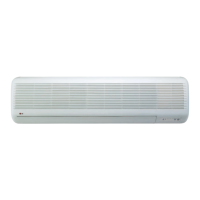-37-
3. Evacuation
■
Connect the charge hose end described in the
preceding steps to the vacuum pump to evacuate
the tubing and indoor unit.
Confirm the "Lo" knob of the manifold valve is
open. Then, run the vacuum pump.
The operation time for evacuation varies with tubing
length and capacity of the pump. The following
table shows the time required for evacuation.
■ When the desired vacuum is reached, close the
"Lo" knob of the manifold valve and stop the
vacuum pump.
4. Finishing the job
■ With a service valve wrench, turn the valve stem
of liquid side valve counter-clockwise to fully
open the valve.
■ Turn the valve stem of gas side valve
counter-clockwise to fully open the valve.
■ Loosen the charge hose connected to the gas
side service port slightly to release the pressure,
then remove the hose.
■ Replace the flare nut and its bonnet on the gas
side service port and fasten the flare nut securely
with an adjustable wrench. This process is very
important to prevent leakage from the system.
■ Replace the valve caps at both gas and liquid
side service valves and fasten them tight.
This completes air purging with a vacuum pump.
The air conditioner is now ready to test run.
(1) Remove the caps from the gas side and liquid side valves.
(2) Remove the service-port cap from the gas side valve.
(3) To open the gas side valve turn the valve stem counter-
clockwise approximately 90°, wait for about 2~3 sec, and
close it.
(4) Apply a soap water or a liquid neutral detergent on the
indoor unit connection or outdoor unit connections by a
soft brush to check for leakage of the connecting points of
the piping.
(5) If bubbles come out, the pipes have leakage.
Soap water method

